The first thing I would like to draw the attention of mothers is that ALL complementary feeding tables on the Internet promoted under the auspices of WHO have nothing to do with the World Health Organization.
WHO does not indicate the sequence and quantity of introduction of products!
There is not a word in WHO documentation about the need for baby food vegetable oil or butter!
The only table that can be used when referring to WHO is located on its official website.
I recommend that you read the section “Complementary feeding” in the methodological book “Feeding and Nutrition” infants and children early age", developed by WHO. You can download it from this link .
The table below is just one of the modifications, compiled on the basis of the main WHO recommendations.
When to introduce complementary foods?
« Around the age six months The child's energy and nutrient needs begin to exceed those levels at which point they can be satisfied with breast milk and the introduction of complementary feeding becomes necessary. At this age, the child is ready to eat other foods and is developmentally ready. Not introducing complementary foods after the baby reaches six months of age or inappropriately introducing complementary foods can affect the baby's growth»
How to introduce complementary foods?
“The first food offered to the child should be mashed foods consisting of one ingredient, soft consistency, without added sugar, salt, or hot seasonings such as curry powder or hot peppers. Positive examples include non-wheat grains such as home-cooked and mashed rice, mashed potatoes, and soft, thick porridges made from traditional grains (such as oats, and pureed vegetables and fruits). You can add it to the puree to soften it. breast milk or baby formula" (Feeding and nutrition of infants and young children, WHO Regional Publication, European Series, No. 87).
Why is it worth preparing complementary foods yourself?
Excerpt from WHO document: « ...The quality of commercially produced supplementary food products is extremely heterogeneous. Some of them make it possible to compensate for the lack of certain nutrients in the diet of young children, while others, on the contrary, cause concern due to their high content of added sugars and salt. » (WHO, Maternal and early childhood nutrition infancy, EB 138/8 of January 15, 2016).
According to WHO, guidelines for appropriate complementary feeding are as follows:
“ - continue frequent, on-demand breastfeeding until the child reaches two years of age or more;
- be sensitive when feeding your baby (for example, directly feed infants and assist older children. Feed slowly and patiently, encourage but not force, talk to your baby and maintain eye contact);
- practice good hygiene and proper food handling;
- Start at the age of six months with small amounts of foods and gradually increase them as the child gets older;
- gradually increase the consistency of food and make it more varied;
- increase the number of feedings of the child - 2-3 times a day for children aged 6-8 months and 3-4 times a day for children aged 9-23 months with 1-2 additional snacks at the child's request;
- use fortified foods or vitamin and mineral supplements for complementary feeding as needed;
- increase fluid intake, including through breastfeeding, and offer soft, favorite foods.” (WHO fact sheet N°342 “Infant and young child nutrition”, January 2016).
According to the above data, a weekly table for introducing complementary foods was compiled. The order in which products are introduced is based on the degree of allergens they contain: from least to most. However, when introducing complementary foods it is worth considering individual characteristics baby, varying the order of introduction of new products.
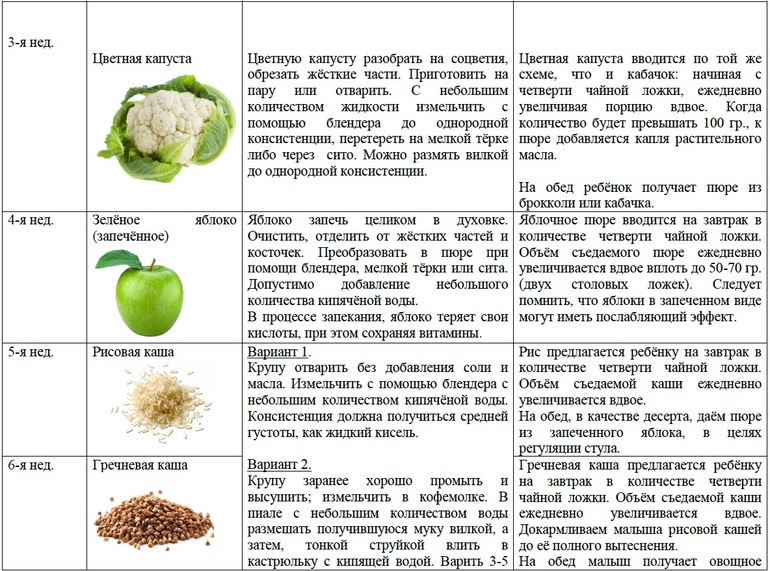
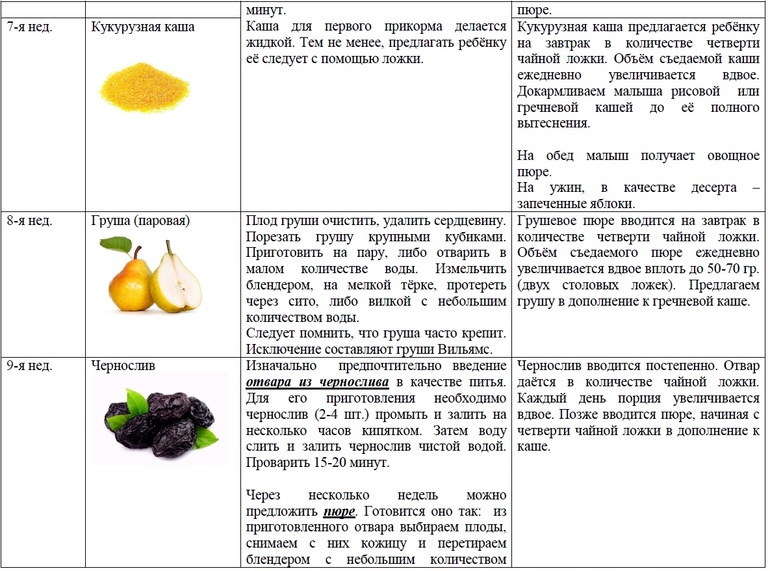
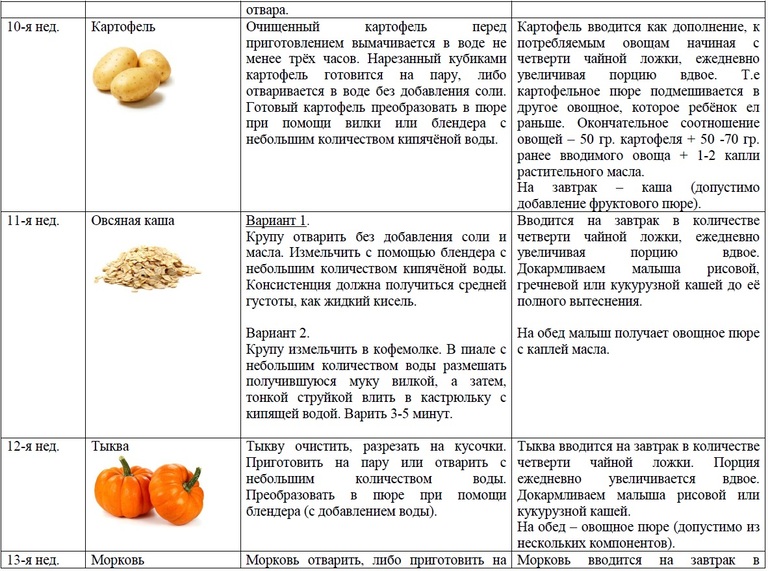
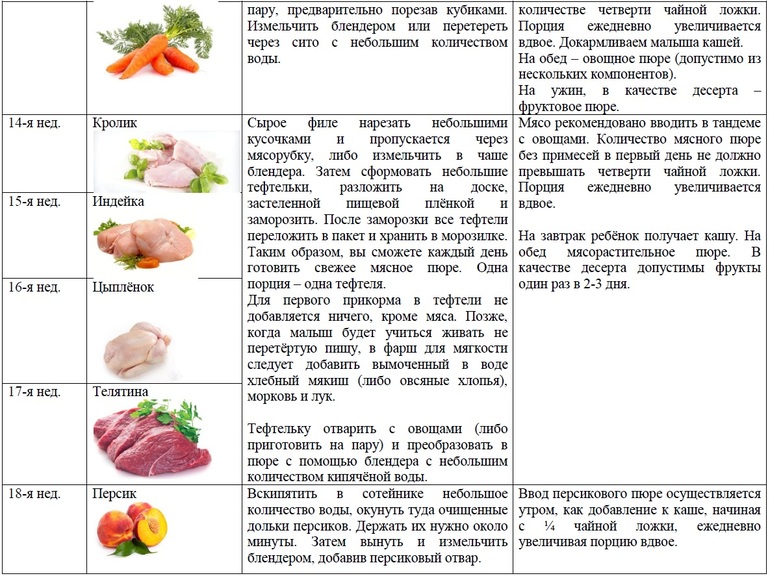
April 5, 2016
The first feeding is not such an easy task for young mothers. We will try to fully cover all aspects of this issue so that you do not have any questions and everything is very clear. The first thing a mother needs to start complementary feeding is this table of complementary feeding for children under one year old, which will help you understand what needs to be given to the child first and what second.
For young mothers: Introduction of complementary feeding
There are certain WHO recommendations for introducing certain foods into the diet of babies under one year of age. There is a table current for 2016, which contains all the WHO recommendations regarding changes in feeding babies and the introduction of vegetables, fruits, cereals, meat and other products into their menu.
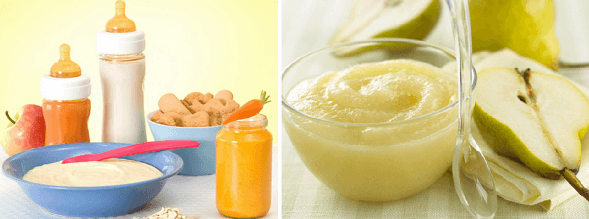
| Days | New product | Grams | Teaspoons | Previously introduced product | Grams | Teaspoons |
| 1 | Zucchini puree | 3 | 0,5 | |||
| 2 | 8 | 1 | ||||
| 3 | 20 | 3 | ||||
| 4 | 40 | 7 | ||||
| 5 | 70 | 12 | ||||
| 6 | Zucchini puree and 1 tsp vegetable oil, if the portion is already more than 100 g. | 120 | 20 | |||
| 7 | Vegetable puree from zucchini +1 tsp. vegetable oil | 170 | 28 | |||
| 8 | Cauliflower puree | 3 | 0,5 | Vegetable puree (zucchini) +1 tsp. rast. oils | 167 | 27,5 |
| 9 | 8 | 1 | 162 | 26,7 | ||
| 10 | 20 | 3 | 150 | 24,7 | ||
| 11 | 40 | 7 | 130 | 21,3 | ||
| 12 | 70 | 12 | 100 | 16,3 | ||
| 13 | Vegetable puree ( cauliflower) + growth oil | 120 | 20 | Zucchini puree | 50 | 8,0 |
| 14 | 170 | 28 | ||||
| 15 | Broccoli vegetable puree | 3 | 0,5 | Vegetable puree from broccoli and vegetables. oil | 167 | 27,5 |
| 16 | 8 | 1 | Zucchini puree and vegetable matter. oil | 162 | 26,7 | |
| 17 | 20 | 3 | Cauliflower puree | 150 | 24,7 | |
| 18 | 40 | 7 | Zucchini puree | 130 | 21,3 | |
| 19 | 70 | 12 | 100 | 16,3 | ||
| 20 | Broccoli vegetable puree | 120 | 20 | Zucchini puree | 50 | 8,0 |
| 21 | 170 | 28 | 0 | 0,0 | ||
| 22 | Buckwheat | 3 | 0,5 | |||
| 23 | 8 | 1 | ||||
| 24 | 20 | 3 | ||||
| 25 | 40 | 7 | ||||
| 26 | Buckwheat + table. spoon of cream oils | 70 | 12 | |||
| 27 | Buckwheat porridge + butter | 120 | 20 | |||
| 28 | Buckwheat porridge with butter | 170 | 28 | |||
| 29 | Rice | 3 | 0,5 | Buckwheat porridge + cream. porridge | 167 | 27,5 |
| 30 | 8 | 1 | 162 | 26,7 | ||
| 31 | 20 | 3 | 150 | 24,7 | ||
| 32 | 40 | 7 | 130 | 21,3 | ||
| 33 | 70 | 12 | 100 | 16,3 | ||
| 34 | Rice + 1 spoon of butter | 120 | 20 | buckwheat | 50 | 8,0 |
| 35 | 170 | 28 | ||||
| 36 | Corn porridge | 3 | 0,5 | Buckwheat porridge + butter | 167 | 27,5 |
| 37 | 8 | 1 | Rice + butter | 162 | 26,7 | |
| 38 | 20 | 3 | Buckwheat + butter | 150 | 24,7 | |
| 39 | 40 | 7 | Rice + butter | 130 | 21,3 | |
| 40 | 70 | 12 | Buckwheat porridge | 100 | 16,3 | |
| 41 | Corn porridge | 120 | 20 | Rice | 50 | 8,0 |
| 42 | 170 | 28 | ||||
| 43 | Pumpkin vegetable puree | 3 | 0,5 | 167 | 27,5 | |
| 44 | 8 | 1 | Zucchini puree | 162 | 26,7 | |
| 45 | 20 | 3 | Broccole puree | 150 | 24,7 | |
| 46 | 40 | 7 | Vegetable puree from cauliflower | 130 | 21,3 | |
| 47 | 70 | 12 | Zucchini puree | 100 | 16,3 | |
| 48 | Pumpkin puree | 120 | 20 | Broccoli puree | 50 | 8,0 |
| 49 | 170 | 28 | ||||
| 50 | Fruit applesauce | 3 | 0,5 | Buckwheat porridge | 170 | 28,0 |
| 51 | 8 | 1 | Rice porridge | 170 | 28,0 | |
| 52 | 16 | 3 | Corn porridge | 170 | 28,0 | |
| 53 | 25 | 4 | Buckwheat | 170 | 28,0 | |
| 54 | 35 | 6 | Rice | 170 | 28,0 | |
| 55 | 48 | 8 | Corn porridge | 170 | 28,0 | |
| 56 | 60 | 10 | Buckwheat porridge | 170 | 28,0 | |
| 57 | Millet porridge | 3 | 0,5 | Buckwheat porridge | 167 | 27,5 |
| 58 | 8 | 1 | Rice | 162 | 26,7 | |
| 59 | 20 | 3 | Corn porridge | 150 | 24,7 | |
| 60 | 40 | 7 | Buckwheat | 130 | 21,3 | |
| 61 | 70 | 12 | Rice porridge | 100 | 16,3 | |
| 62 | Millet porridge | 120 | 20 | Corn porridge | 50 | 8,0 |
| 63 | 170 | 28 |
Complementary feeding by month
| Child's age (month) | Required calories per day, kcal/day | Consistency of complementary foods | Product | Amount of complementary foods |
| A little over 6 | 200 | Liquid or creamy consistency | Choose buckwheat, corn and rice porridge, they do not contain gluten. Vegetable and fruit purees from pumpkin, zucchini, potatoes, cabbage or broccoli, apples, peaches, plums, apricots and |
Complementary foods can be given 1-2 times a day. The portion gradually increases from the tip of a spoon to 1-2 teaspoons. This happens within one week. tummy. |
| 7 | 200 | Puree prepared in a blender | We introduce dietary meat (veal, rabbit, turkey, chicken). You can give half a chicken egg per week. A little whole cow's or goat's milk. |
Give complementary foods three times a day. The first portion is 1 teaspoon and increase to 3 tablespoons after a week, then increase the portion to 150 ml. |
| 8 | 200 | Puree made with a blender | Lean meat. Soft cheese. |
We give complementary foods three times a day. We start with a teaspoon and over the course of a week we increase to 200 ml of one of the products. |
| 9-11 | 300 | Puree made using a blender | Low-fat boiled meats. Dairy products and whole cow's milk. |
We give it three times a day. |
| 12 | 500 | Finely chopped pieces, the juice does not need to be diluted with water and sweetened with sugar. |
We provide all previously introduced products. Give the juice drop by drop. |
The portion of complementary foods increases to 250 ml. We give complementary foods 4 times a day. The portion of juice increases to 80-100 ml. |
Menu for children under one year old
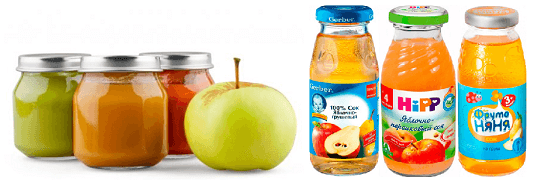
There is a menu developed by WHO for children under one year old. It involves the gradual introduction of all food products, and it also takes into account all the WHO recommendations that are given to mothers of babies who are both on artificial and artificial breastfeeding.
Complementary foods that will make up the menu for babies up to a year old can be prepared at home yourself. The main thing is to choose the freshest and most proven products so that the introduction of new dishes goes smoothly and without surprises for your baby. WHO recommends complementary feeding both during breastfeeding and artificial feeding using factory-produced baby purees, since the products for them undergo strict quality checks.
First feeding, what you need and where to start
When breastfeeding
For mothers who decide to stop breastfeeding their babies, WHO recommends the following menu to introduce into the baby's diet.
At 6 months, a mother who is breastfeeding her baby may begin to give:
- At 6 am for breakfast, breast milk is about 160-200 grams.
- At 10 am, about 150 grams of porridge and 50 grams of milk when breastfeeding.
- At two o'clock in the afternoon, vegetable puree 150 grams, meat puree 30 grams, juice or milk 30-50 ml.
- At six in the evening, 60 grams of fruit puree and 140 grams of supplementary food.
- Before going to bed at 10 pm we give breastfeeding, the child should drink about 200 grams, as recommended by WHO.
At the age of seven months, breastfed babies eat:
- At 6 am, about 200 grams of mother's breast milk.
- At 10 am, about 150 g of porridge, half a yolk and breast milk until the baby is full.
- At two o'clock in the afternoon, lunch consists of 140 g of vegetable puree, 30 g of meat puree and 30-70 g of juice or milk.
- At about 6 pm we eat 70-100 g of fruit puree and supplement until the baby is full.
- At 10 pm only milk during breastfeeding is 170-200 grams.
For children aged eight months, the introduction of such a menu is acceptable 2016:
- At six in the morning the baby eats breast milk about 180-220 g.
- At ten in the morning he has breakfast with porridge about 180 g, half an yolk, fruit puree 30 g and breast milk.
- At 2 o'clock in the afternoon, about 100 g of vegetable and meat puree, also about 80 g of fruit puree, drink either juice or milk from 30 to 70 ml.
- At six in the evening you can give 100 g of yogurt, as well as 40 g of fruit puree, and breastfeed the baby until the baby is full.
- At 10 pm breast milk only 180-215 g.
For nine-month-old babies the menu will be something like this:
- At 6 am 190-220 g of milk.
- At 10 am, 180 g of porridge, half an yolk, juice or breast milk as a supplement.
- At two o'clock in the afternoon, vegetable puree with meat puree of about 200 g, fruit puree of 40 g and supplementary feeding with juice or breast milk are acceptable.
- At 6 pm yogurt 100 ml, cottage cheese 50 g and the rest is supplementary food.
- At 10 pm only 190-226 grams of milk.
For ten and eleven month old babies it is acceptable to introduce such a diet:
- At 6 am breast.
- Around 10 am, 180 g of porridge, half a yolk, 30 grams of fruit puree, up to 250 grams of the rest of the milk.
- At two o'clock in the afternoon we eat 80 grams of vegetable puree, 125 grams of meat puree, and supplement up to 250 grams with milk or juice.
- At six in the evening, 100 ml of yogurt, 50 g of fruit puree, 50 g of cottage cheese, up to 250 g of the rest, breastfeeding.
- At 10 pm 200-250 breast milk.
When the baby is one year old, he can be fed:
- At 6 am only 270 g of breast milk.
- At 10 am, 180 g of porridge, half an yolk, 70-100 g of milk or juice.
- At two o'clock in the afternoon, fish puree 200 g, fruit puree 40 g, supplementary food 30 grams.
- Closer to 6 pm, a milk drink with fruits and cereals 130 grams, 50 g of cottage cheese and the rest up to 270 grams of breastfeeding.
- At ten in the evening, 270 g of breast milk.
With artificial feeding
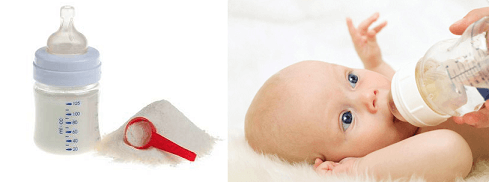
There is a sample menu for children under one year of age who are not breastfed, but bottle-fed. It is compiled in accordance with WHO recommendations for infants for introducing complementary foods.
How to introduce a baby's first complementary foods while breastfeeding and artificial feeding
For children aged 5 months:
- At 6 am he gives 180 ml of formula.
- At 10 am we have breakfast with 120 grams of vegetable puree and give 50 ml of the mixture.
- For lunch, dinner and before bedtime we give 180 ml of milk mixture.
- At 6 am we eat 180 ml of formula.
- For breakfast at 10 am, 120 g of porridge and 60 g of fruit puree.
- For lunch at 2 o'clock in the afternoon, 120 g of vegetable puree and 50 ml of juice.
- For dinner and before bed, 180 ml of milk mixture.
At 7 months babies eat:
- Early in the morning 180 ml of formula.
- Around ten in the morning, 120 g of porridge with 50 grams of cottage cheese, to which 60 g of fruit puree was added.
- For lunch at two o'clock, 120 g of vegetable puree with half an yolk, washed down with 70 ml of juice.
- For dinner at 6 pm we eat 180 ml of formula milk and 50 g of fruit puree. You can drink only crackers.
- At ten in the evening we eat 200 ml of formula.
Babies should be eating as early as 8 months:
- At 6 am, 180 ml of formula.
- For breakfast at 10 am, about 120 g of porridge and half an yolk. And also 60 g of fruit puree.
- At two o'clock I served 150 ml of vegetable soup and 50 g of meat puree.
- We have dinner at 6 pm: 100 ml of Narine with milk mixture and 50 g of fruit puree. We also give 50 g of cottage cheese and a small cracker.
- Dinner at 10 pm - 200 ml of milk formula.
At 9 months the baby eats:
At 7-00 180 ml of milk formula + cookies.
At 11-30 120 g of porridge + 1/2 yolk + 60 g of fruit puree or fruit.
At 15-30 150 ml of vegetable soup + 50 g of meat in the form of a steam cutlet or casserole.
At 19-00 100 ml NARINE with milk mixture + 50 g fruit puree + 50 g cottage cheese + crackers.
At 22-30 200 ml of milk formula.
At the age of 10 months the child eats:
- In the morning, 180 ml of milk formula + small cookies.
- At 11:30 150 ml of vegetable soup and 50 g of meat (cutlet or casserole).
- At 15:30, 120 g of porridge with half an yolk, and also 60 g of fruit puree or fruit.
- At 19:00, 100 ml of Narine in milk mixture with 50 g of fruit puree. Also another 50 g of cottage cheese and one cracker.
- Dinner at half past ten - 200 ml of Narine.
At 11 months the baby should be eating:
- For breakfast, 180 ml of Narine milk mixture with several cookies.
- Half 12 150 ml of vegetable soup and 50 g of meat, it can be a steamed cutlet or casserole.
- At half past four, 120 g of porridge and half an yolk, as well as 60 g of fruit puree or just fruit.
- At 7 pm, give the child 100 g of Narine on milk formula and with 50 g of fruit puree and 50 g of cottage cheese, you can give one cracker.
- Before going to bed we eat 200 ml of Narine.
When a child turns one year old, he should eat:
- At 8 am, 200 g of milk porridge with half an yolk and 75 ml of fruit juice.
- For lunch, 100 ml of vegetable soup and for the second 125 g of vegetable puree with 70 g of meat or
steamed fish cutlet. You can wash everything down with 75 ml of fruit or vegetable juice. - For an afternoon snack, mix 100 g of cottage cheese with 50 grams of fruit puree (= or fruit (as a separate dish) + 150 ml of Narine.
- We have dinner with 100 g of vegetable puree or vinaigrette and 100 ml of narine.
- At night we eat only 200 ml of Narine.
Porridge for first feeding
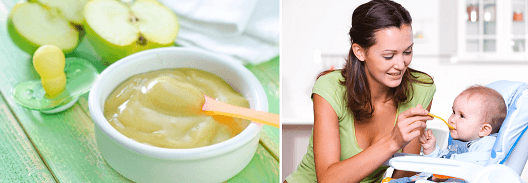
When the little one turns 7 months old, if possible, start cooking and giving porridge a little at a time. Mothers should know that gluten-free cereals should be given, preferably rice, buckwheat and specialized corn porridge for small children.
It is better to let the cereal sit in water for a little while, sort it out, rinse it and cook it only in water. It is absolutely not necessary to cook it in milk, moreover, it is not advisable. You need to add your expressed breast milk to the finished porridge crushed in a blender; if you are feeding your baby with artificial formula, then you can add a little mixture to the porridge.
The approximate ratio of dry cereal and water should be 5 grams of porridge per 100 ml of water. If the porridge is tolerated normally, then you will need to cook 10 grams per 100 ml. Gradually, as the child grows, you can make the porridge more and more thick. If the baby is breastfed, feed the baby porridge from a spoon, not a bottle, otherwise the baby may stop breastfeeding.
First feeding. Useful tips for moms
The introduction of complementary foods during breastfeeding is a cause for doubt and concern for every mother. But all these worries can be easily dispelled, based on the recommendations of experienced pediatricians and the conclusions of the World Health Organization (WHO), which tell us how to properly introduce complementary foods to a child.
General rules for introducing first complementary foods
If you decide to introduce your first complementary foods, be sure to follow the following rules:
- the child must be completely healthy;
- this cannot be a week period before or after vaccination;
- you need to start only with one-component formulations;
- a new product should be introduced after the baby has completely gotten used to the previous one (no earlier than 5-6 days);
- the consistency of complementary foods should be semi-liquid, absolutely homogeneous, without the smallest lumps or fibers;
- the first portion of a new product is always 0.5 teaspoon, followed by a gradual increase in portion;
- the first complementary foods are introduced in the morning feeding followed by breastfeeding;
- carefully monitor changes in the child’s well-being (loose or hardening of stools, the appearance of a rash on the body, excessive regurgitation, flatulence, anxiety). In case of negative reactions of the child’s body, exclude this product for a while and change it to another one.
Remember that the purpose of the first complementary foods is not to feed the baby, but to introduce him to a new product, a new taste, a new sensation, no matter how long you start feeding him. This is another step in a child’s knowledge of the world around him. Don’t interfere with your baby’s attempts to recognize new food by touch; give him the opportunity and time to try and love “adult” foods. Often a taste that you didn’t like the first time becomes your favorite after a while.
Give your baby the opportunity to determine for himself how much complementary food he will eat. When the baby turns away and does not want to eat any more purees or porridge, continue feeding by applying it to the breast.
When deciding to introduce complementary foods, study diagrams and tables that will help you find answers to your most important questions: when, how much and what product you can start giving to your baby. Any doubts should be dispelled during consultation with a specialist.
Feeding order
Scheme 1
There is no single answer to this question. Dr. Evgeny Komarovsky strongly recommends starting complementary feeding with fermented milk products, because their composition is very close to mother’s breast milk, and fermented milk bacteria destroy microbes that cause various infections.
- Start giving your baby fresh, unsweetened kefir that is completely homogeneous in consistency. The first portion is 1-2 teaspoons, gradually increase it to 100-150g.
- When the baby gets used to it, a week after the first complementary feeding, you can carefully mix 1 teaspoon of cottage cheese into kefir (make sure that the mixture is free of lumps and compactions). Over the course of a month, increase the amount of cottage cheese to 30g.
- At 7 months, introduce non-dairy cereals made from buckwheat, corn, oatmeal or rice, ground almost to powder in a coffee grinder.
- By 7.5 months, you can introduce your baby to vegetable puree.
- At the next stage, the baby is ready to digest fruit puree from a green apple or banana.
- After getting used to cereals, fruits and vegetables, we offer the baby meat puree.
Scheme 2
- We start the first feeding with vegetable puree. The table of the order of introducing vegetables into a baby’s diet will help you choose the very first vegetables for your baby. Definitely, they will be white or green, non-allergenic, neutral in taste (zucchini, cauliflower, broccoli).
- For the very first complementary foods in the form of puree, boil or bake vegetables, chop thoroughly, grind the vegetable mass through a fine sieve, add expressed breast milk or a drop of vegetable oil. The vegetable puree should be warm and smooth.
- When the child gets used to vegetables, introduce porridge into his diet by 7 months.
- Then we introduce the baby to fermented milk products (kefir, cottage cheese, yogurt without chemical additives).
- At 8 months, start feeding your baby fruit purees.
- By 9 months, introduce meat into your baby's diet.
Scheme 3
This scheme for introducing complementary foods into a child’s diet is recommended for weakened children who are not gaining weight well.
- At 6 months, the first non-dairy porridges made from buckwheat, oatmeal, corn or rice, ground in a coffee grinder, are introduced.
- By 7 months, we add vegetable purees to the baby’s diet.
- From 7.5 months we introduce kefir, yogurt without any additives and cottage cheese into the child’s diet.
- Then you can start giving your child cereal with milk. Remember that whole cow's milk can cause allergies. Therefore, at the first stage, dilute it with water in half. You should not add sugar to porridge.
- Semolina and millet (well ground) cereals can be used to prepare porridge from 9 months.
- When the baby is well acquainted with cereals and various vegetables, it’s time to get acquainted with fruit purees.
- At 8-9 months we supplement complementary feeding with meat purees.
- By 10-11 months, when the baby gets used to meat tastes, lunch can be formed from meatballs or cutlets with a side dish of porridge.
Fruit complementary foods
There is an opinion that it is customary to start feeding infants with fruit juices and purees. However, most WHO experts are convinced that fruits are extremely undesirable for babies under 8 months, because fruit complementary foods are given raw, and the stomach and intestines of a child who is still only breastfed is not yet completely ready to absorb and process such food. Therefore, porridge, kefir and vegetable purees will prepare small organisms for painless assimilation of fruits.
Bread, fish and water
Don't rush into introducing bread into your baby's diet. Rich white bread is especially undesirable. From 9-10 months, you can introduce your baby to crackers and regular biscuits without any flavorings or chemical additives.
Fish is introduced into the children's diet after meat by 10 months. The first fish purees are prepared from lean fish (pike perch, hake). Carefully and thoroughly remove bones from fish fillets. Grind well, achieving homogeneity of the mass.
Diagrams and a table that systematize the types and order of introduction of complementary foods by month of the baby’s life will help you decide on the order of introducing foods into your baby’s diet:
- table of the order of introducing fruits into the baby's menu.
With the introduction of the first complementary foods, start giving your baby water. Give your baby something to drink between feedings. Introduce water into your diet gradually, starting with 1-2 teaspoons. Do not insist if the baby refuses to drink water right away. Please try again in a few days. Give your little body the opportunity to regulate its own needs.
Dear mothers, the introduction of the first complementary foods is a new step in your baby’s maturation, no matter how old you started it. Be careful and take your time with the variety of children's menus. If in any doubt, seek advice from your pediatrician. Always take into account the individual characteristics of your child’s body. Grow up healthy!
The introduction of complementary foods is a crucial period in the life of mother and baby. At this time, the child's first acquaintance with adult food occurs. Our recommendations and table of complementary feeding for children up to one year will help the mother to properly organize complementary feeding by month for the baby.
- The child must be healthy at the time of introduction of complementary foods.
- All types should be given before breastfeeding. The only exception is juices, which should be given after breastfeeding.
- The dosage of each type in the first feeding should be no more than 5 g. Within 1-2 weeks, this volume is increased to 150 g.
- A child should be introduced to a new product only after the previous one has been well mastered.
- Food for the baby in the first days of complementary feeding should be homogeneous, that is, well crushed, and not cause discomfort when swallowing. Gradually, the consistency of the dish may become thicker and more uneven.
- Only one dish should be offered per meal.
- The food should be warm.
- One type of complementary food should not be given twice a day.
- You need to carefully monitor your baby's stool. Any violations are a reason to stop complementary feeding for a while or replace it with another product.
- It is not recommended to introduce complementary foods during the vaccination campaign.
- When introducing vegetables and fruits as complementary foods, it is not recommended to take red and orange foods. It is better to start with neutral greens that do not cause allergies.
- It is better not to boil dishes for your baby, but to steam them. This way they will retain more vitamins and nutrients.
- Introduce complementary feeding without violence. Don't force your baby to eat if he doesn't want to. Introduce complementary foods carefully and gradually. As a last resort, replace the product.
- Feed your baby with a spoon.
- Do not add salt to your dishes, especially in the first months.
- Milk can be used to prepare vegetable purees and porridges.
- The amount of kefir consumed by a child depends on the volume of the mixture eaten.
- Fruit juices should be diluted half and half with water. Fruit puree is given a couple of weeks after the introduction of juices.
When to start complementary feeding?
There is no clear answer to this question. During the Soviet period, it was recommended to introduce complementary foods in the form of fruit juices from 3 months. Today, WHO and UNICEF in their publications recommend feeding full-term and normally developing children exclusively with breast milk for up to 4-6 months. In this regard, pediatricians in Russia and European countries speak out against complementary feeding for up to 6 months.
However, there are exceptions. Babies at 4-5 months may not have enough nutrients and calories from mother's milk. In this case, it is recommended to introduce complementary foods and supplementary feeding with artificial formulas. This rule also applies to bottle-fed children. It is recommended to introduce them to adult food at 4.5-5.5 months.
The time of introducing complementary foods for a particular child should be adjusted according to several indicators:
- baby's weight;
- general physical development(the digestive system must be mature to accept adult food);
- health;
- presence of teeth.
If all criteria are normal, you can proceed. By 5-6 months, the organs of the digestive system of a full-term baby mature to accept roughage.
How to introduce complementary foods?
The first dish a child is introduced to can be vegetable puree or porridge. This is what WHO advises. However, the famous pediatrician E. Komarovsky proposed a different scheme for introducing complementary foods. He recommends starting with fermented milk products: kefir, cottage cheese. This order also has a right to exist and is quite logical, since it is easier for a child’s stomach to switch from breast milk to dairy products than to boiled vegetables.
The mother makes her choice solely on the basis of the physiological characteristics of the baby. If vegetable puree is not suitable, you can try offering porridge to your baby.
If vegetable puree was chosen, it is recommended to start complementary feeding with zucchini. It contains a lot of vitamins. At the same time, it is easy to prepare, perfectly digestible and does not cause allergies. After a few weeks, you can introduce your baby to cabbage and potatoes. 
You can make your own vegetable puree or buy it at a baby food store. When purchasing, you need to pay attention to the age of the child indicated on the jar, from which puree is recommended. The consistency of the food depends on this.
Another option is canned baby vegetables based on vegetables, which are prepared with minimal addition of salt.
It is better to offer legumes, tomatoes, carrots, beets, and onions to the baby after 7-8 months, when the stomach is prepared for this.
A couple of weeks after introducing vegetables, you can invite your child to try porridge. It could be buckwheat, rice, corn grits. They do not contain gluten, a strong allergen. For the same reason, it is not recommended to start complementary feeding with semolina porridge.
The scheme for introducing complementary foods involves introducing cottage cheese and kefir at 7-8 months. The reason for such a late acquaintance of the baby with WHO dairy products is explained by allergenic proteins in the composition of these products. The maximum dosage of cottage cheese per day is calculated based on 3-5 g per 1 kg of baby’s weight. You should not dilute cottage cheese with kefir: this increases the amount of protein and puts a strain on the kidneys.
At the same time, you can give boiled egg yolk, starting with 1/4.
At 7-8 months, the baby becomes familiar with raw fruits and meat. First, you can use canned meat or ready-made purees.
If you cook meat yourself, it is preferable to start with well-ground and steamed minced meat. A little later, you can cook meatballs, and closer to the year - cutlets. Meat should be lean varieties (beef, veal, chicken). It is better to steam it without salt. The amount of meat consumed is calculated in the same way as cottage cheese.
As the year approaches, you can prepare soups using vegetable broths. Meat broths contain many purines, which are harmful to the child’s immature kidneys.
At 9 months, low-fat varieties of fish (cod, pike perch, saury), steamed, are introduced. Lightly salted fish can be introduced closer to the year. It contains a lot of calcium and vitamins A and B.
The table for introducing complementary foods allows you to systematize information about the order of introduction and the volume of products offered to the baby.
| Name | 3 months | 4 months | 5 months | 6 months | 7 months | 8 -9 months | 10-12 months |
|---|---|---|---|---|---|---|---|
| Fruit juice | 5-25g | 30-45g | 45-60 g | 65-70 g | 80 g | 80-90g | 100 g |
| Fruit puree | 5-25g | 30-45g | 45-60g | 65-70 g | 80 g | 80-90g | 100 g |
| Vegetable puree | 10-90g | 140-150g | 160 g | 170 g | 180 g | 200 g | |
| Milk porridge | 50-90g | 140-150g | 160-170g | 180 g | 200 g | ||
| Cottage cheese | 10-30g | 40 g | 40 g | 40 g | 60 g | ||
| Meat puree | 5-25 g | 50 g | 60 g | ||||
| Fish puree | 30-40g | 50 g | |||||
| Kefir, fermented milk products | 200 g | 200 g | 400-500 g | ||||
| Milk | 100 g | 150 g | 150 g | 200 g | 200 g | ||
| Crackers | 3-5 g 5 g | 5 g | 10 g | ||||
| Vegetable oil | 1-2 g | 3 g | 5 g | 5 g |
The complementary feeding table gives only an approximate idea of how much and at what time it is recommended to give complementary foods. Every mother should be guided not only by generally accepted norms, but also by the needs of her child. If the baby does not receive enough nutrition, and complementary feeding is needed already at 4 months, it must be introduced.
How to introduce complementary foods during the week?
Many mothers are puzzled by how to correctly distribute the amount of complementary feeding throughout the day so as not to harm the baby. The following complementary feeding scheme for every day (vegetable puree is taken as an example) gives an idea of how to distribute portions of food for a baby throughout the week, gradually increasing its volume. However, it is worth remembering that these standards are also approximate and must be adjusted individually.
- Monday – 1 tsp. (5 g)
- Tuesday – 2 tsp.
- Wednesday – 3 tsp.
- Thursday – 4 tsp.
- Friday – 50 g
- Saturday – 100 g
- Sunday – 150 g
When starting to introduce complementary foods for your baby, focus primarily on the needs of your own child. Remember that any standards given by WHO are aimed at the average baby. Your child is an individual. Focus on general rules, but listen to your baby.
For parents, the introduction of the first complementary foods to a child is an event of incredible importance: just yesterday the baby ate exclusively breast milk (or a special milk formula), and today he is trying his first “adult” food! Naturally, parents have a thousand and one questions:
- What is the procedure for complementary feeding?
- What foods should be introduced into complementary feeding first: porridge, vegetables, or maybe immediately offer the baby a cutlet?
- How much should a child eat at one time?
- Why does a child refuse to eat healthy vegetable puree?
- What is a baby's food diary?
Well, let's look at it in order.
Complementary feeding plan
Let's start our debriefing, perhaps, with a table for introducing complementary foods to children in their first year of life. Here it should be noted that over the past few decades, pediatrics has made quite a significant step forward, and the tables for introducing complementary foods from 4 months, which can be found in Soviet books, are no longer relevant. Now pediatricians recommend introducing complementary foods not from 4, but from 6 months.
Table (schedule) for introducing complementary foods
| Type of complementary foods | When to enter | Where to start |
| Vegetables | From 6 months (from 5-5.5 months according to indications) | One-ingredient puree of white or green vegetables |
| Fruits | From 6 months | One-component puree from soft fruits |
| Dairy-free porridge | From 6-7 months (from 5-5.5 months according to indications) | |
| Milk porridge | From 7-8 months | Gluten-free cereal porridges (rice, buckwheat) |
| Fermented milk products | From 8-9 months | Children's kefir, yogurt, biolact without additives |
| Cottage cheese | From 9 months | Children's cottage cheese without additives |
| Meat | From 8 months | Meat puree from veal, rabbit, turkey |
| Liver, tongue, heart | From 10 months mixed with meat puree; 12 months in pure form | Mixed with meat puree, no more than 1-2 times a week |
| Fish | From 8-10 months | Low-fat sea fish no more than once a week |
| Eggs | From 7-8 months | Up to a year, only the yolk is given, starting from 1/8 of the |
| Vegetable oil | From 6 months | Starting with 3-5 drops. Preference: corn olive oil, but sunflower is also possible |
| Butter | From 7 months | Starting from 1/8 teaspoon |
| Berries | From 12 months | Starting with dull berries, carefully monitoring the reaction |
| Juice | From 10-12 months | Starting with clarified juices from dull fruits |
| Children's cookies | From 9 months | Up to 12 months no more than 3-5 pieces per day |
Please note: This table shows the approximate timing of introducing complementary foods for healthy breastfed children. For children who are bottle-fed or mixed-fed, complementary foods are usually introduced at the age of 5-5.5 months. In any case, parents should consult their pediatrician before introducing complementary foods.
Which product to choose for the first complementary feeding?
The introduction of certain complementary foods is a rather individual matter and requires consultation with a pediatrician. We can only give general recommendations. Thus, for healthy children who are gaining weight well, vegetable puree is recommended as the first complementary food. This can be a one-ingredient puree of zucchini, broccoli or cauliflower. For children with reduced weight, dairy-free cereal porridge is recommended as the first complementary food. For example, buckwheat, corn or rice. As for delicious fruit purees, they can also be introduced as the first complementary food, however, often after “sweet” babies refuse to eat vegetable purees.
How much should a child eat at one time?
The serving size directly depends on the baby’s age: a full serving of vegetable puree or porridge for a six-month-old toddler is 50–70 grams, but by the age of one year its volume increases to 200 grams per meal. At the same time, each new product is introduced into the child’s diet gradually, starting with half a teaspoon with a gradual increase in volume over the course of a week to a full serving.
Volume of complementary foods introduced by month
| Dish | Volume depending on age (in grams) | ||||
| 6 months | 7 months | 8 months | 9 months | 10-12 months | |
| Vegetables | 50-100 | 150 | 170 | 180 | 200 |
| Fruits | 40-50 | 50-70 | 50-70 | 80 | 90-100 |
| Dairy-free porridge | 50-100 | 150 | 170 | 180 | 200 |
| Milk porridge | - | 100-150 | 100-150 | 180 | 200 |
| Fermented milk products | - | - | 50-100 | 100-150 | 150-200 |
| Cottage cheese | - | - | - | 10-30 | 30-50 |
| Meat | - | - | 5-30 | 30-50 | 50-60 |
| Liver, tongue, heart | - | - | - | - | 5-30 |
| Fish | - | - | 10-20 | 30-50 | 50-60 |
| Eggs (yolk) | - | ⅛-¼ yolk | ¼-½ yolk | ½ yolk | 1 yolk |
| Vegetable oil | ½ teaspoon | ½ teaspoon | 1 teaspoon | 1 teaspoon | 1 teaspoon |
| Butter | - | ½ teaspoon | 1 teaspoon | 1 teaspoon | 1 teaspoon |
| Berries | - | - | - | - | 50 |
| Juice | - | - | - | - | 50-100 |
| Children's cookies | - | - | - | 1-3 pcs. | Up to 5 pcs. |
Why does a child refuse complementary feeding?
Children refuse new foods for several reasons, including:
- lack of food interest (i.e. the child is not yet interested in “adult” food);
- the child is not hungry (a complementary feeding dish is offered to the baby after the main feeding);
- the child is unwell (teething, tummy ache, runny nose, etc.);
- didn’t like the taste of the dish;
- the child is tired and wants to sleep.
Remember: If a child refuses the food offered, forcing him to eat by force (including distracting him with cartoons, toys and “theatrical performances” performed by relatives) is strictly prohibited. Such “actions” provoke the baby to develop incorrect eating habits and subsequently lead to a decrease in appetite.
To ensure that the child always eats with appetite, when introducing complementary foods, parents should follow a few simple rules:
- Complementary feeding is always offered to the child BEFORE the main feeding, and not after;
- new products are introduced into complementary foods only for an absolutely healthy child;
- if the child does not show interest in “adult” food, the introduction of complementary foods can be postponed a little;
- if a child “actively” does not like a certain product, try to lure him with another, but from the same group (i.e. we replace broccoli with zucchini, rice porridge with buckwheat, etc.).
And most importantly, never, under any circumstances:
- do not force-feed the child;
- do not distract the child while eating;
- Don't be distracted yourself while feeding your baby.
How to introduce complementary foods to a child prone to allergies?
For babies prone to allergies, complementary foods are introduced with extreme caution and only after consultation with a pediatrician. Also, parents of such children need to keep a special “food diary” for the baby, in which they should record the name of the product being introduced and the child’s reaction to it.
Children with allergies should begin introducing complementary foods with a minimum amount of ¼ teaspoon, gradually increasing the portion and carefully monitoring the baby’s reaction to food. A new product begins to be introduced no earlier than 10 days after the previous product is fully introduced into the menu. As a rule, zucchini or cauliflower puree is used as the first complementary food, and brightly colored vegetables (for example, pumpkin, carrots, etc.) are introduced 1-2 months after the start of complementary feeding. Eggs, whole milk, fish, honey and other highly allergenic foods should not be introduced until one year of age.
Resume
The formation of eating habits begins with the first feeding of the baby. Failure to follow the rules at this important stage can negatively affect the baby’s health. Thus, introducing complementary foods too early can provoke the appearance of allergies, even intolerance to certain foods; too late can lead to the development of vitamin deficiency, anemia, etc. “Force” feeding provokes problems with appetite; eating “with cartoons” can lead to systematic overeating and, as a result, obesity. To avoid these problems, follow the rules for introducing complementary foods and adhere to the recommendations of your doctor.
Girls! Let's repost.
Thanks to this, experts come to us and give answers to our questions!
Also, you can ask your question below. People like you or experts will give the answer.
Thank you ;-)
Healthy babies to all!
Ps. This applies to boys too! There are just more girls here ;-)
Did you like the material? Support - repost! We try our best for you ;-)



